Products You May Like
Receive $50 off an eligible $100 purchase at the Outside Shop, where you’ll find gear for all your adventures outdoors.
Sign up for Outside+ today.
Imagine exploring both rainforests and vibrant mountain meadows within just a few miles on the same trail, all with a glacier-capped volcano rising in the background. That’s exactly what the Wonderland Trail is: a 93-mile (150 km) trek around Mt Rainier, the most glaciated peak in the lower 48 states. Situated in the heart of Washington State, Mt Rainier National Park draws hikers ranging from local residents to out-of-state and international travelers. Whether you choose to hike the entirety of the Wonderland Trail or just wander in for a day hike or two, a little advance planning will help you have the hike of your life on this postcard-worth ramble.
Permits and logistics
There are essentially 3 areas where you can enter Mount Rainier National Park and access the Wonderland Trail. Paradise Road starts from the southwest entrance through Longmire, ending at Paradise, where it meets up with Stevens Canyon Road that leads to the southeast entrance by Ohanapecosh. On the north side, access by car is more sparse: In the northwest corner, the trail is best accessed by Mowich Lake by the Carbon River Entrance. Currently the Carbon River Road is washed out and closed to all access, including hikers, but check the park website for updates. . In the northeast corner, the Sunrise Entrance has a few spots to access the Wonderland Trail, by the Sunrise Visitor Center and lower on the road by White River Campground.
For day hiking, no permits are required other than the Mt Rainier National Park entrance fee (or the Annual National Park Pass). If you choose to explore the Wonderland Trail on a multi-day trip, you’ll need a wilderness permit to use any of the 18 campsites right next to the trail. The early-access reservation lottery is your best bet for a multiday trip, but a third of wilderness permits remain first-come, first-serve for walk-ins at a wilderness information center.
Unless you’re an elite ultrarunner, you’ll need to dedicate at least a few days to cover the Wonderland Trail. Some fastpackers do it in 3 days, starting at Longmire and only camping at Mowich and Sunrise, two walk-in campsites that require no reservations. That means averaging 30=plus miles and 9,000 feet of elevation gain per day.
For the average backpacker, a longer trip will be a more pleasant way to enjoy this park. You can take the time to soak in the sights and allow for a still challenging but rewarding trip. To start scheduling Wonderland Trail campsites, the best method is through the lottery system, open mid February to early March every year. Successful applicants will have an early reservation opportunity between late February and early March.. Although 1,800 applicants will be given a window to reserve, only 600 Wonderland thru-hikes are available during this early reservation period, meaning it’s still competitive even if you win the lottery.
Following the lottery, the remaining campsites open for reservations in late April. Outside of that, it is possible to piece together the remaining campsites, although you may have days of uneven hiking lengths—a 2-mile day and then a 15-mile day, for example—if you cannot get your ideal campsites. There is often more availability for partial Wonderland Trail backpacking trips. Below, we offer a sample itinerary to maximize the best campsites, averaging 5-10 miles each day.
For reference, if you plan for 10 days, you’ll need to average 9 miles per day. For a 2-week hike, you can cut the mileage down to about 7 miles per day. To start planning, first determine how far you and your group are capable of hiking with a heavy overnight pack. Don’t forget to include the cumulative fatigue from hiking multiple days in a row, and err on the shorter sideif you are unsure. This is a good baseline for how far apart you want your campsites to be. Use the Wilderness Trip Planner to help you sketch out your trip.
If you plan for a trip longer than about a week, it may be beneficial to store your food midway at a food cache or have a friend meet up with you to help restock your supplies. Good places to do this are at Mowich and Sunrise.
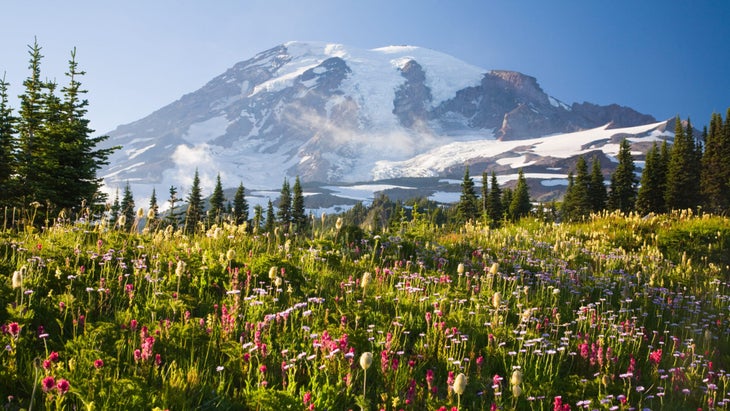
When to visit
The most beautiful time to visit the Wonderland Trail is mid summer when the snow has just melted, the wildflowers are out, and the weather is stable and sunny. The highest point in the trail is at 6,750 feet (Panhandle Gap), which doesn’t melt out until late June or early July, so hikers attempting the route before midsummer will need to be prepared for snow travel. Spring is also tricky since the large amount of snowmelt creates extreme flows that can damage bridges and trails, which will need to be fixed by a trail crew before visitors can safely pass. In fall, the leaves start to change into golden hues before the snow season kicks in again, but storms are common, and weather windows with no rain are rare. Check the conditions on the park’s site.
Wonderland Trail: Section by Section
This is an overview of the trail going clockwise starting at Longmire, although any other starting point and direction can work too.
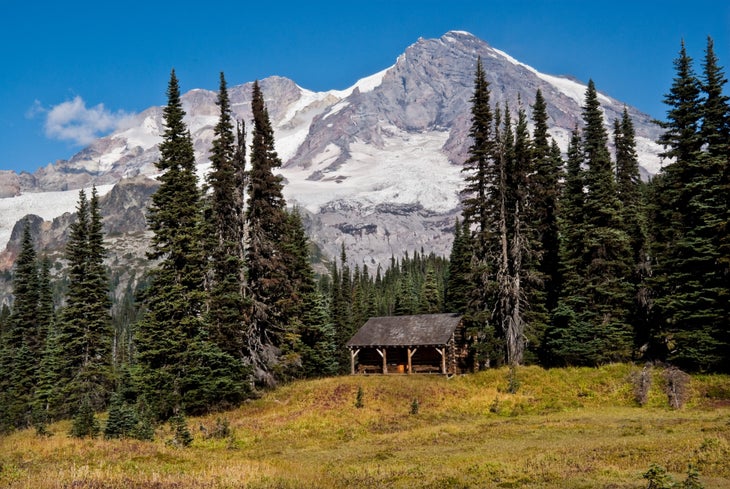
Longmire to Carbon River
First up, the westerly stretch from Longmire to Carbon River is filled with deep forest walks, glacial rivers, and colorful subalpine meadows. The Wonderland Trail first departs Longmire into the forest, taking you past Rampart Ridge. (The ridge is also a great additional 1.5 mi detour starting from Longmire for more views of Rainier.) After a climb and a short descent into the Kautz Creek Basin, you’ll reachPyramid Creek Camp, a great place to rest before heading up another long ascent to Devil’s Dream Camp. As you continue past the field of purple lupine flowers surrounding Squaw Lake, you’ll quickly find yourself at Indian Henry’s Hunting Grounds. It’s got one of the most photogenic views of Rainier with an open subalpine meadow and a lovely ranger patrol cabin to bring you back in time.
If you can peel yourself away from those bewitching meadows, the moderate trail will take you to the famous Tahoma Creek Suspension Bridge, the longest bridge in the national park. It’s a jaw-dropping airy crossing above the glacial melt river and the swinging bridge is not for the faint of heart. A short climb brings you up and around Emerald Ridge for a great view of Glacier Island, a mass of rock rising from the Tahoma Glacier. Enjoy another rich meadow before descending back into the forest to the South Puyallup River Camp. Just a short few minutes walk further and take a look at the unique Devil’s Pipe Organ, a conglomerate of columnar lava cliffs.
Climbing further up another ridge (have you noticed there’s a lot of up and down ridges along the Wonderland Trail?), take a break at the aqua-blue St Andrews Lake at mile 18, then head on to Klapatche, one of the most beautiful campsites around Rainier, which boasts another green-blue lake with that subalpine view of Rainier. This is a prime tent spot for the sunset alone, which lights up Rainier at dusk.
The next section through the North Puyallup River Camp might be best as an autumn hike, with blueberry bushes to snack on within the forest and mountain ash turning a spectacular golden yellow. Continue on to the campsite at Golden Lakes. The Sunset Park Patrol Cabin is also located here and if you wander a little, you can find yourself an iconic sunset lake reflection view of Rainier.
Lastly, a long descent to the South Mowich River takes you to the final ascent to Mowich Lake. Be careful crossing the river. Sometimes a log bridge will take you across and other times, you may need to pick your way through the silty rocks. (Poles are a great idea here.)
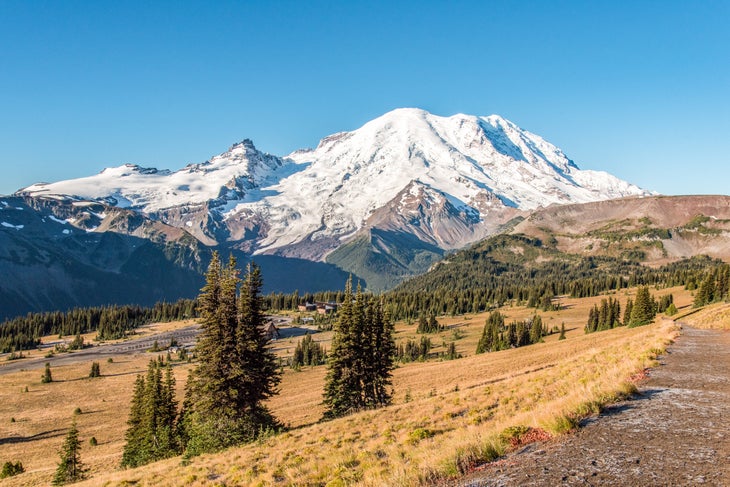
Mowich to Sunrise
This northerly section is often done as the Northern Loop Trail, taking alternate routes from the Wonderland Trail to make a round trip path. It’s got a large variety of scenery, from wide-open river beds created by the melting glaciers to fields of wildflowers to the vast, outer space-like ambiance of monochrome ash formed by an andesitic lava flow.
Take some time to enjoy the Mowich section, where you can restock with your food cache at the patrol cabin, catch up with friends over lunch by the picnic tables, or take a stroll around the many trails here. Tolmie Peak Lookout has one of the best vantage points of Rainier. Eunice Lake below is teeming with wildflowers. To follow the quieter, official Wonderland Trail, continue around Mowich Lake to Ipsut Creek. Or, if you don’t mind the busier alternate route, hike through Spray Park, a wildflower paradise.
Ipsut Creek Camp is not too far from Mowich and offers a lowland experience by the Carbon River. Walking along the Carbon River, you’ll cross another incredible suspension bridge, albeit shorter than the Tahoma Creek bridge. Soon, you’ll climb out of the river bed and pop out to Mystic Lake, which hosts another campsite and ranger station. The lake is a welcome sight with Old Desolate, a lonely mountain towering 1,000 feet above the lake, making for a slight change in background. Situated between the Carbon Glacier and Winthrop Glacier, Mystic Lake is a little fertile oasis nestled amongst trees.
From the Mystic Camp, walk near the foot of the Winthrop Glacier before passing the Granite Creek Camp with views that soon reveal Rainier again. You’re in for a treat as you head towards Sunrise (the Northeast Entrance of the park) with views that are, literally, other-worldly. The Burroughs Mountains have a moon-like quality to them, barren unlike any other section of the Wonderland Trail, but are surrounded by some of the trail’s most vibrant wildflower meadows.
Sunrise has many side trails and camps to choose from that are slightly off from the main Wonderland Trail. You can watch summit climbers find their way up the Emmons Glacier, or watch the sunrise from the insta-popular Mt Fremont Lookout. Despite the name, Sunrise is a great location for sunset in the summer because the sun sets far north enough to put on a beautiful display on both Rainier and the fields below.
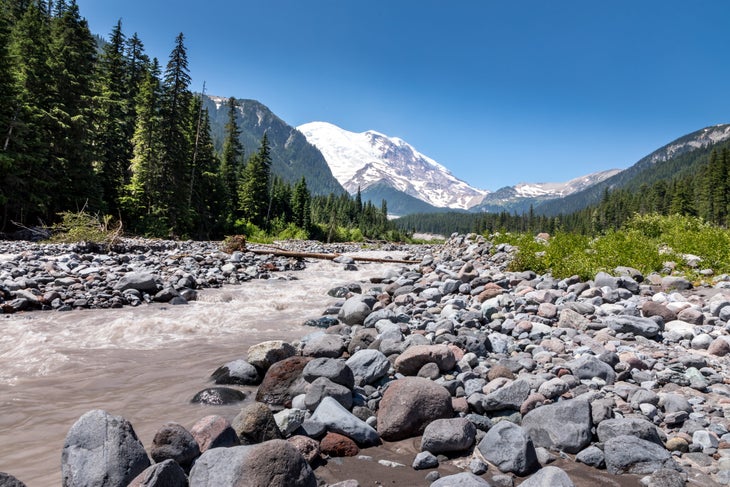
Sunrise to Longmire
It may be hard to leave the diverse landscapes of Sunrise, but some quieter yet still stunning sections of the Wonderland Trail are coming. Pass the White River Campground and pick up the trail as it follows Fryingpan Creek up to Summerland. Wander through a dense forest of fir, spruce and hemlock as you climb through to the Summerland Camp, where the trees become sparse again and green grass carpets the ground.
Before long, the luscious green will transition briefly into the dry moon-like landscapes again at Panhandle Gap. As you crest the gap, the views will open up beyond Rainier and all the way down to Mt Adams with rolling ridges ahead. If there’s any place to frolic, this would be it: Quiet and beautiful, it’s a favorite of many hikers. Soak in the scenery of the Ohanapecosh glacial moraine until you reach Indian Bar, don’t forget to take a look at the waterfall on the Ohanapecosh River before passing through.
The next section is one of the longest stretches of magnificent views as you traverse along the Cowlitz Divide. Instead of the typical pattern of walking up and over a ridge, this time, you get to spend a few miles with Rainier as the main backdrop. At the bottom of the ridge, you’ll end up at Nickel Creek and another section of forest.
Save some time to take a few pictures at Box Canyon, a narrow slot canyon tumbling with whitewater, before you cross the Stevens Canyon Road to follow Stevens Creek uphill. Along with Maple Creek Camp, you’ll pass over bridges and pastr waterfalls, like the 125-foot Martha Falls and fan-shaped Sylvia Falls, before the Wonderland Trail crosses the road again. Reflection Lakes and Louise Lake are great places to stop for lunch and though there may be more visitors in this area, the views of Rainier are hard to beat. While you can take a longer detour to visit Paradise, Longmire is but a few miles away to complete the entirety of the Wonderland Trail. Finish it up with a nice descent along Paradise River, with the babbling water flowing alongside the trail as you pass the hustle bustle of Cougar Rock Campground. The trail will deposit you back at Longmire, where you can kick back in one of their outdoor wicker chairs and pat yourself on the back for the successful thru-hike.
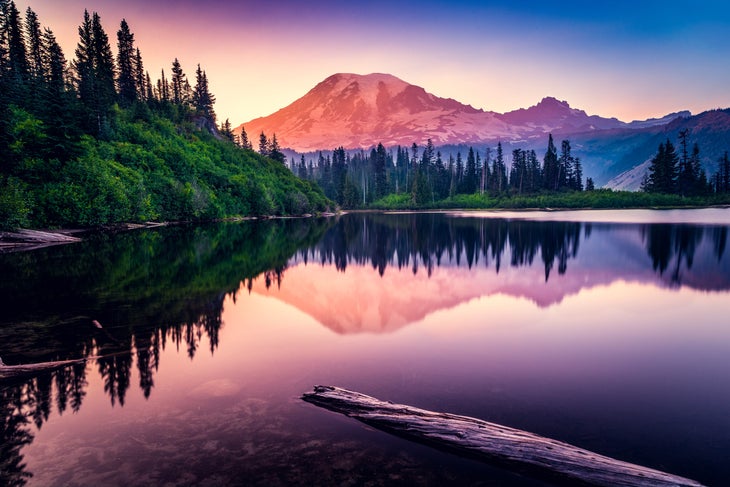
Hiking the Wonderland Trail: Tips
Make sure to bring insulation and a rain shell; this is the PNW alpine, and storms aren’t unlikely. The Wonderland Trail also has some of the country’s most beautiful campsites, and you’ll also want to make the most of your time there. Bring something that you’ll enjoy at camp, whether it’s a book or game or hot chocolate.
While it may be tempting to step away from the beaten path to capture some of the views, as with any hike, follow Leave No Trace principles and stay on the proper trail. The wildflower meadows here are extremely fragile, especially given how many visitors come to the park.
